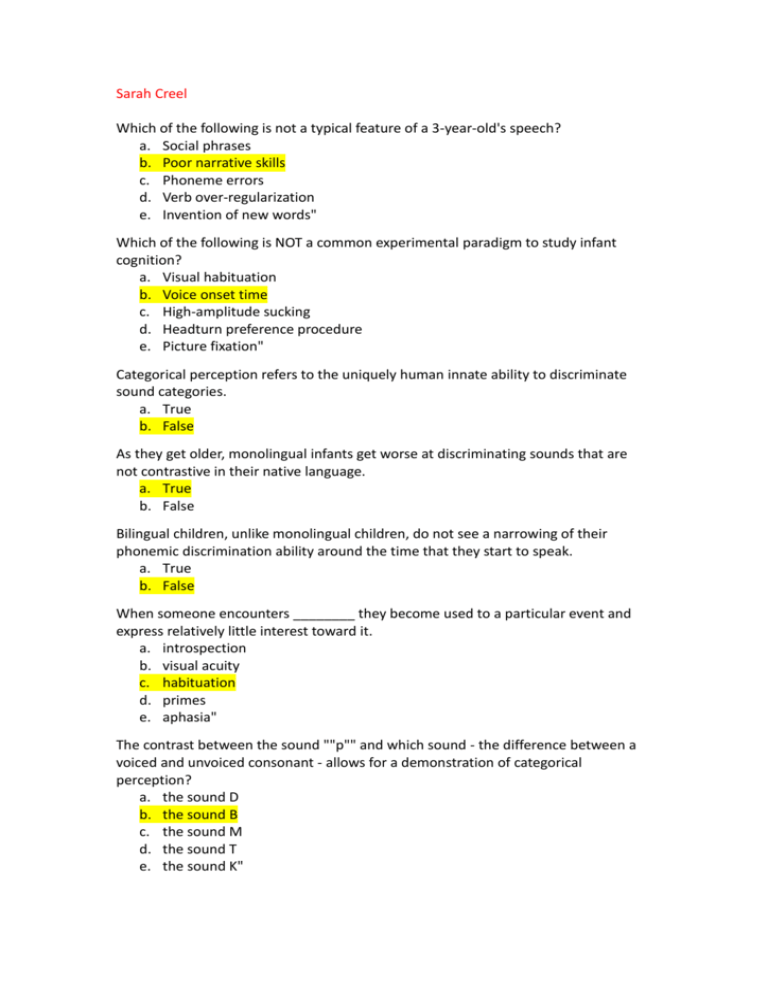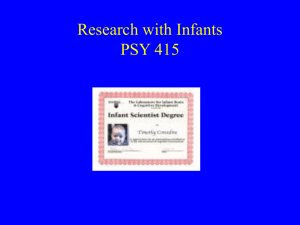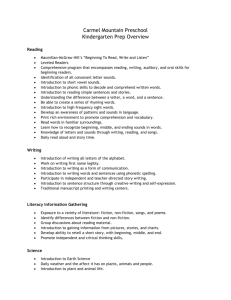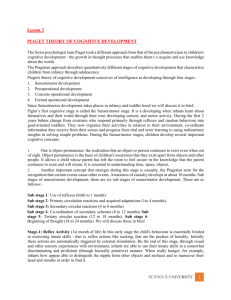SarahCreel - UCSD Cognitive Science
advertisement

Sarah Creel Which of the following is not a typical feature of a 3-year-old's speech? a. Social phrases b. Poor narrative skills c. Phoneme errors d. Verb over-regularization e. Invention of new words" Which of the following is NOT a common experimental paradigm to study infant cognition? a. Visual habituation b. Voice onset time c. High-amplitude sucking d. Headturn preference procedure e. Picture fixation" Categorical perception refers to the uniquely human innate ability to discriminate sound categories. a. True b. False As they get older, monolingual infants get worse at discriminating sounds that are not contrastive in their native language. a. True b. False Bilingual children, unlike monolingual children, do not see a narrowing of their phonemic discrimination ability around the time that they start to speak. a. True b. False When someone encounters ________ they become used to a particular event and express relatively little interest toward it. a. introspection b. visual acuity c. habituation d. primes e. aphasia" The contrast between the sound ""p"" and which sound - the difference between a voiced and unvoiced consonant - allows for a demonstration of categorical perception? a. the sound D b. the sound B c. the sound M d. the sound T e. the sound K" Infants tend to lose the ability to discriminate between consonants of a foreign language sound later than between vowels. a. True b. False "Which is used as a measure of an infant's attention in the headturn preference procedure? a. Voice onset time b. Spoken questions c. Looking time d. Brain blood flow" "Which is an experimental method used to determine whether an infant groups two stimuli in the same or different categories? a. Habituation b. Categorical perception c. Button presses d. Eye tracking e. a and d "The phenomenon in which people are much better at discriminating speech sounds that are across a category boundary than within a category is known as: a. Picture fixation b. Phonemes c. Categorical perception d. Voicing" Unlike adults, babies do not show categorical perception. a. True b. False Children probably use statistical computations to determine what sequences of sounds might form real words in their (future) language. a. True b. False "A child saying ""blowed up"" rather than the correct way of ""blew up"" is an example of: a. Habituation b. Over-regularization of verbs c. Over-pronunciation of verbs d. Vision-directed sound change e. Phoneme errors" The Head-turn Preference Procedure (HPP) studies what an infant is saying to understand what they are thinking. a. True b. False "Habituation refers to: a. Learning a speech sound so many times it becomes a habit. b. The procedure of looking into infant sucking times to determine their future speech habits. c. The decrease in response to a stimulus after repeated exposure to that stimulus over time. d. Repeated use of a habitual action to learn a speech sound. e. A method of looking at the voice onset time in different sounds." Voice Onset Time (VOT) is the time between the beginning of a word being said and the end (the final phoneme) of that same word being said. a. True b. False "How do infants learn sound patterns? a. use voice onset time between various sounds to find patterns. b. high amplitude sucking shows that infants use habituation to find sound patterns c. learn vowels first and then find patterns of when vowels are used throughout longer sounds d. use pauses in sounds to determine patterns e. hear all possible sounds and narrow down those that are contrasts in their language" "Canadian infants can distinguish German /u/ versus German /y/ at: a. 4 months b. 6 months c. 8 months d. 10-12 months" Word boundaries are clear. a. True b. False "Japanese speakers have only one category for r vs. l sounds. Because they do not separate these sounds, we would expect they would not show a __________ in the same place as native English speakers. a. category boundary b. segmentation boundary c. sonorant d. frictative" Children's inability to produce a sound correctly (e.g. ""wif"" instead of ""with"") reflects not knowing how the sound is actually pronounced in English. a. True b. False











